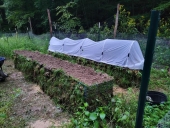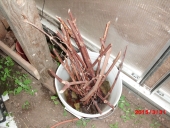Angela Wilcox wrote:Gosh darn this looks interesting. Congratulations on making something that meets your needs. They look great!
I wonder what would happen if you turned your shingles grass side in? And oh! I just thought…what if the shingles grew something chickens could forage on like a fedge thingy? Food on top for humans, food on the sides for chickens.
Yes! I was thinking about possibilities along these lines. I do think that turning them grass side in would work as well, especially if done in early spring. The root structure would hold together, and the new weed seeds sleeping in the turf would grow out. I love the chicken feed idea! I'd cover the hoops over with chicken fencing to keep them out, and give them free reign on everything they can reach.
I think I'll also experiment in this way: in the spring, lay the cattle panels on a sheet of plastic on the ground, cover lightly with soil, and sow something into the whole structure (I was thinking creeping thyme, but open to suggestions-- perennials necessary). Then once there was a good root structure in place, I'd pick up the panel, set it in place, and fill it in with dirt. I expect someone could make something that looks quite pretty this way, too.
One concern I have about this structure is that the weed roots will grow too far into the center and rob my crops. I got an impression from some source or another that when you cut the leafy growth of a plant, the roots die back proportionally. If this is true, having chickens grazing on the "weeds" (or just trimming them with a weed eater) would keep this problem at bay. Can anyone confirm that this is how root growth works?








